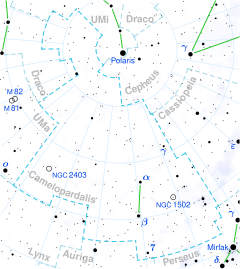
Back Beta Camelopardalis Afrikaans Beta Camelopardalis AST Beta de la Girafa Catalan Beta Camelopardalis Czech Beta Camelopardalis German Beta Camelopardalis Spanish Beta Camelopardalis Estonian بتا زرافه Persian Beta Camelopardalis Finnish Beta Camelopardalis French
| Observation data Epoch J2000 Equinox J2000 | |
|---|---|
| Constellation | Camelopardalis |
| Right ascension | 05h 03m 25.08963s[1] |
| Declination | +60° 26′ 32.0895″[1] |
| Apparent magnitude (V) | 4.02[2] |
| Characteristics | |
| Spectral type | G1Ib–IIa[3] |
| U−B color index | +0.62[2] |
| B−V color index | +0.93[2] |
| R−I color index | +0.49[2] |
| Astrometry | |
| Radial velocity (Rv) | −1.90[4] km/s |
| Proper motion (μ) | RA: −6.50[1] mas/yr Dec.: −14.15[1] mas/yr |
| Parallax (π) | 3.74 ± 0.21 mas[1] |
| Distance | 870 ± 50 ly (270 ± 20 pc) |
| Absolute magnitude (MV) | −3.1[5] |
| Details | |
| Mass | 6.5[3] M☉ |
| Radius | 58±13[6] R☉ |
| Luminosity | 1,592[7] L☉ |
| Surface gravity (log g) | 1.79[3] cgs |
| Temperature | 5,300[3] K |
| Metallicity [Fe/H] | −0.06[8] dex |
| Rotational velocity (v sin i) | 11.7[9] km/s |
| Age | 53[3] Myr |
| Other designations | |
| Database references | |
| SIMBAD | data |
| Data sources: | |
| Hipparcos Catalogue, CCDM (2002), Bright Star Catalogue (5th rev. ed.) | |
Beta Camelopardalis, Latinised from β Camelopardalis, is the brightest star in the northern constellation of Camelopardalis. It is bright enough to be faintly visible to the naked eye, having an apparent visual magnitude of 4.02.[2] Based upon an annual parallax shift of 3.74 mas as seen from Earth, it is located roughly 870 light-years from the Sun. It is moving closer with a radial velocity of −1.90 km/s[4] and is most likely a single[10] star.
This is a yellow-hued G-type supergiant/bright giant with a stellar classification of G1 Ib–IIa.[3] It is an estimated 60 million years old and is spinning with a projected rotational velocity of 11.7 km/s.[9] This is an unusually high rate of rotation for an evolved star of this type. One possible explanation is that it may have engulfed a nearby giant planet, such as a hot Jupiter.[11]
Beta Camelopardalis has 6.5[3] times the mass of the Sun and has expanded to around 58[6] the Sun's radius. The star is radiating 1,592[7] times the Sun's luminosity from its enlarged photosphere at an effective temperature of 5,300 K.[3] It is a source of X-ray emission.[12]
β Cam has two visual[10] companions: a 7th-magnitude A5-class star at an angular separation of 84 arcseconds; and a 12th-magnitude star at 15 arcseconds.[13]
- ^ a b c d e Van Leeuwen, F. (2007). "Validation of the new Hipparcos reduction". Astronomy and Astrophysics. 474 (2): 653–664. arXiv:0708.1752. Bibcode:2007A&A...474..653V. doi:10.1051/0004-6361:20078357. S2CID 18759600.
- ^ a b c d e Ducati, J. R. (2002). "VizieR Online Data Catalog: Catalogue of Stellar Photometry in Johnson's 11-color system". CDS/ADC Collection of Electronic Catalogues. 2237. Bibcode:2002yCat.2237....0D.
- ^ a b c d e f g h Lyubimkov, Leonid S.; Lambert, David L.; Korotin, Sergey A.; Rachkovskaya, Tamara M.; Poklad, Dmitry B. (2015). "Carbon abundance and the N/C ratio in atmospheres of A-, F- and G-type supergiants and bright giants". Monthly Notices of the Royal Astronomical Society. 446 (4): 3447. arXiv:1411.2722. Bibcode:2015MNRAS.446.3447L. doi:10.1093/mnras/stu2299.
- ^ a b Gontcharov, G. A. (2006). "Pulkovo Compilation of Radial Velocities for 35 495 Hipparcos stars in a common system". Astronomy Letters. 32 (11): 759–771. arXiv:1606.08053. Bibcode:2006AstL...32..759G. doi:10.1134/S1063773706110065. S2CID 119231169.
- ^ Gray, David F.; Pugh, Teznie (2012). "The Third Signature of Granulation in Bright-giant and Supergiant Stars". The Astronomical Journal. 143 (4): 92. Bibcode:2012AJ....143...92G. doi:10.1088/0004-6256/143/4/92.
- ^ a b Cite error: The named reference
vanBelle2009was invoked but never defined (see the help page). - ^ a b McDonald, I.; Zijlstra, A. A.; Boyer, M. L. (2012). "Fundamental parameters and infrared excesses of Hipparcos stars". Monthly Notices of the Royal Astronomical Society. 427 (1): 343–357. arXiv:1208.2037. Bibcode:2012MNRAS.427..343M. doi:10.1111/j.1365-2966.2012.21873.x. S2CID 118665352.
- ^ Kovtyukh, V. V.; Gorlova, N. I.; Belik, S. I. (2012). "Accurate luminosities from the oxygen λ7771-4 Å triplet and the fundamental parameters of F-G supergiants". Monthly Notices of the Royal Astronomical Society. 423 (4): 3268. arXiv:1204.4115. Bibcode:2012MNRAS.423.3268K. doi:10.1111/j.1365-2966.2012.21117.x. S2CID 118683158.
- ^ a b Rodrigues Da Silva, R.; Canto Martins, B. L.; De Medeiros, J. R. (2015). "On the Nature of Rapidly Rotating Single Evolved Stars". The Astrophysical Journal. 801 (1): 54. arXiv:1503.03447. Bibcode:2015ApJ...801...54R. doi:10.1088/0004-637X/801/1/54. S2CID 119271718.
- ^ a b Cite error: The named reference
mnras389_2_869was invoked but never defined (see the help page). - ^ Rodrigues da Silva, R.; Canto Martins, B. L.; De Medeiros, J. R. (March 2015). "On the Nature of Rapidly Rotating Single Evolved Stars". The Astrophysical Journal. 801 (1): 6. arXiv:1503.03447. Bibcode:2015ApJ...801...54R. doi:10.1088/0004-637X/801/1/54. S2CID 119271718. 54.
- ^ Cite error: The named reference
apjss184_1_138was invoked but never defined (see the help page). - ^ Mason, Brian D.; Wycoff, Gary L.; Hartkopf, William I.; Douglass, Geoffrey G.; Worley, Charles E. (2001). "The 2001 US Naval Observatory Double Star CD-ROM. I. The Washington Double Star Catalog". The Astronomical Journal. 122 (6): 3466. Bibcode:2001AJ....122.3466M. doi:10.1086/323920.
